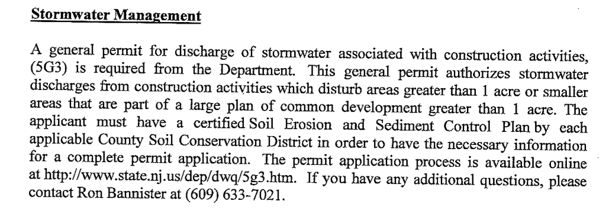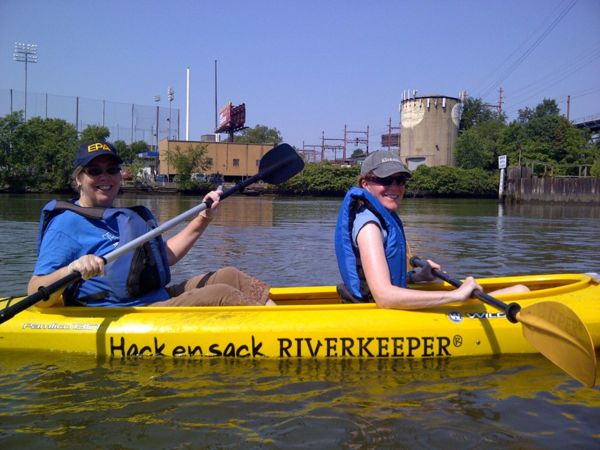DEP Buries Federal Clean Water Act Power Under Preempted State ENSP Program
[Update below]
Some of my PennEast opponent friends are praising the latest DEP environmental review letter to FERC on the PennEast pipeline, so, unfortunately, I again must be the skunk at the Garden Party and clarify the situation (see prior post).
Federal law includes the doctrine of preemption of State and local laws (curious wonks can read the Wiki backgrounder).
The federal Natural Gas Act under which FERC reviews interstate pipelines like PennEast preempts most state and local laws, with very limited exceptions.
This Congressional Research Service Report explains:
Certificate Authorities
If FERC grants a pipeline certificate, the commission’s order will state the terms and conditions of the approval, including the pipeline route that has been authorized, as well as any construction or environmental mitigation measures required for the project. A FERC certificate confers on the developer eminent domain authority (15 U.S.C. §717f(h)). Also, federal law preempts any state or local law that duplicates or obstructs that federal law (e.g., siting or zoning) relevant to the project. In this way a FERC certificate provides a pipeline developer with the authority to secure property rights to lay the pipeline if the developer cannot secure the necessary rights-of-way from landowners through negotiation. In practice, however, eminent domain authority is considered a last resort and is seldom used by developers.
Although a FERC certificate authorizes a pipeline under the Natural Gas Act, it cannot preempt other federal laws that may apply—such as the Endangered Species Act, the Coastal Zone Management Act, or the Clean Water Act—so any requirements under other federal statutes must still be met by the developer. These may include, for example, securing authorizations for water crossings from the Army Corps of Engineers, permission to cross federal lands from the Bureau of Land Management, and other federal approvals. A developer must secure these other federal approvals before proceeding with pipeline construction.
One of the exceptions that is not preempted are “federal approvals” – and the key one for PennEast that is not preempted is the Water Quality Certification under Section 401 of the Clean Water Act.
Additional support:
Finally, and most significantly, state agencies that implement federally authorized programs, such as the Clean Water Act or Coastal Zone Management Act are not subject to preemption. These statutes “effect a federal-state partnership…so that state standards approved by the federal government become a federal standard for that state” and cannot be overridden by FERC.16** However, sometimes states waive their rights under these federal statutes by failing to act within the required time frame for making a decision (for example, Section 401 of the Clean Water Act requires states to act on an application within one year of the date that it is filed or the need for the approval is deemed waived). ** Note the Connecticut case in FN 16 – Conn. denied a federal permit and killed pipeline – my note
What that all means is that opponents need to find a federal hook that DEP is delegated to enforce – like the Clean Water Act.
However, instead of asserting this federal law based DEP Section 401 WQ Certification power, virtually every issue DEP raises in the most recent FERC review letter is based on state laws, which are preempted.
Again, the one tool they do have under the Clean Water Act – the Section 401 Water Quality Certification – is not even mentioned in the DEP comments to FERC.
The prior DEP letter to FERC completely failed to mention the one federal hook under the Clean Water Act that could be used to build an argument for killing the project under the Clean Water Act, which was 31 Category One (C1) streams the pipeline will cross.
There is no way possible for PennEast to demonstrate that every one of those 31 stream crossings will not lower “existing water quality”, which includes the physical, chemical, and biological characteristics and existing uses of those waters.
But DEP ignored that, and even went one step further and went out of their way to bury their Clean Water Act power
This time around, with all the recent attention given to C1 stream during the legislative veto debate on DEP’s new Flood Hazard rules, DEP could no longer completely ignore the C1 issues.
So, this time around, DEP did MENTION “significant concerns” regarding C1 stream crossings – but on page 19. The concerns the DEP raised were with respect to STATE regulated resources under STATE ENSP law – which are preempted:

But, that’s not the only place where DEP neutered their own Clean Water Act power to kill the pipeline.
There is another federal hook where DEP implements a federally delegated Clean Water Act program that could be a vehicle for showing how the pipeline project would violate federal EPA approved water quality standards under the Clean Water Act.
With a little creative lawyering, if DEP wanted to kill the pipeline, DEP could connect these regulatory dots.
But instead DEP merely mentioned a storm water General Permit (GP) – that regulatory requirements could be used to attack the pipeline for failure to demonstrate compliance with the C1 “existing water quality” standard in the SWQS (NJAC 7:9B) as required by the storm water management rules (NJAC 7:8-5.5(h).

The GP (5G3) is issued pursuant to the NJPDES storm water rules (NJAC 7:14A). Those rules require compliance with the design and performance standards of the storm water management rules (NJAC 7:8) – dots are connected.
What this means is that DEP is just blowing smoke – posturing to make it look like they are being tough. This letter and all the technical issues it raises are largely irrelevant from the perspective of whether they can be used to kill the project.
Finally, I know that some might argue that the DEP’s technical requirements in the FERC letter will delay the project and create regulatory uncertainty.
A recent gas industry consultant’s “Strategic Report” – actually just a survey of the gas industry – found that delays and regulatory uncertainty were the biggest hurdles the industry felt it faced.
This consultant’s Report was not hacked by Anonymous or leaked by an industry whistleblower to Wikileaks.
Just use your head: Do you really think a gas industry consultant is going to write a public report that shows activists how to kill the gas industry?
Ironically, regulatory delays might actually BENEFIT the industry right now – they provide a legal defense from meeting contract commitments and allow industry to avoid making financing decisions until the gas markets improve – i.e higher prices and demand.
If the industry had to finance projects right now and make go/no go decisions, they would be cancelled, just like Shell did with Arctic drilling.
Those that delay gas projects, ironically, may be helping the gas industry through a period of low prices and slack demand.
[Update – I am getting a question about whether NJ wetlands laws could block the pipeline.
First of all, there are federally delegated wetlands and State wetlands issues. NJ Freshwater Wetlands law is preempted. Only federal requirements are relevant to the question.
Second, there are no water quality standards for federally regulated wetlands – or state delegated wetlands – upon which a denial could be based.
Third, wetlands laws set up an avoidance, minimization and mitigation scheme. This does not support a denial.
Fourth, throughout DEP’s entire letter, the concept of mitigation and compensation are stressed – this is not an approach that seeks to deny permits.
All DEP is seeking to do is the big shakedown: force PennEast to pony up mitigation and compensation money in exchange for approval – along with that required by State House Commission for state lands leases and diversion.
It reeks!
Finally, let me add that some are glomming on to the fact that DEP noted State land use permit requirements for a “demonstration of need”.
FERC requires a demonstration of need, so any parallel and inconsistent state requirements are preempted. BPU would be the entity to regulate this anyway. And they don’t, even for intrastate pipelines.
Second, the DEP demonstration of need requirements flow from State land use laws – they are preempted.
Last, energy infrastructure need are totally unrelated to DEP land use laws and environmental laws and DEP has no authority or expertise to weigh in on energy need demonstrations which are not related to wetlands issues. Final straw in preemption.
[End note – and to make matters worse, on top of the preemption issue, almost all of the State DEP permits and approvals merely require mitigation and compensation – that’s very different than a pert denial. DEP is very unlikely to deny any permit and they don’t appear to be even trying to do so, but we’re still in FERC EIS stage.]


